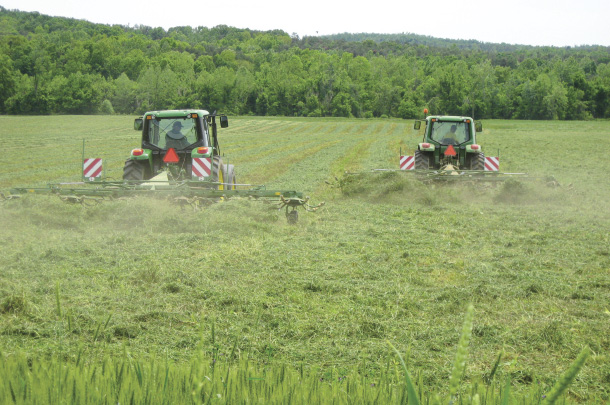To effectively condition hay or haylage, we need to understand the forage drying process:
- The most important forage drying factor is sunlight. Many farmers put hay into a windrow intercepting only 30% to 50% of sunlight falling on the field rather than spreading the swath out and using all of the sunlight falling on the field.
- The second most significant factor in hay drying is swath density. A big windrow insulates the interior forage, keeping it at high humidity and reducing drying rate compared to a windrow/swath that is spread out.
Thus, when comparing conditioners, it is important to think of the outputted windrow design along with the “conditioning” of individual stems. All conditioners will give the swath more of a third dimension (height) and enhance drying.
Leaves dry faster than stems due to the less-sealed surface. Stems are designed to move water from the soil to the leaves without losing water, and the leaves are designed to give off water to cool the plant when it is growing. Factors such as stem diameter and cuticle thickness obstruct water loss of stems when compared to leaves.
Thus, the purpose of conditioners is to enhance water loss from stems by breaking the integrity of their cuticle. The two major types of conditioners are flail or impeller and roller conditioners. Flail/impeller conditioners were developed in Europe for grass hay and haylage. The impellers scrape the waxy coating off portions of the stem to enhance drying. Roller conditioners consist of intermeshing rollers that break and crush the stems.
 Flail conditioners are generally used for grass, since they are less expensive, and roller conditioners are recommended for legumes, since they have less leaf loss. Photo by Lynn Jaynes.
Flail conditioners are generally used for grass, since they are less expensive, and roller conditioners are recommended for legumes, since they have less leaf loss. Photo by Lynn Jaynes.
Both systems tend to enhance drying, especially within the first 12 hours, thereby reducing respiratory loss of plant starch and sugars. With either system, the conditioner must be properly adjusted to ensure rapid drying. Nearly all harvested stems should exhibit some mechanical abrasion when using an impeller conditioner. At least 90% of stems should be broken or crimped every 3 to 4 inches with a roller conditioner. One should get off the tractor after conditioning a few feet of forage and inspect for degree of conditioning.
On impeller conditioning systems, most machines have an adjustable deflector above the impeller, which determines the degree of contact between the forage and impeller. Conditioning is due to the rubbing or abrasion caused by the impeller fingers. Check impeller speed and clearance between the impeller and deflector hood. Adjusting the deflector down will increase the degree of forage conditioning. Narrow the hood clearance for adequate conditioning but not so close that leaves are shredded. Reducing clearance too much results in machine plugging. One can also slow rotor speed to reduce conditioning.
Intermeshing rolls of rubber, urethane or steel condition similarly if properly adjusted. Rubber or urethane are preferred where stones, dirt and other trash may go through the conditioner. On the other hand, they wear out faster than steel rolls and may need to be replaced when roll spacing in the middle is significantly greater than at either end.
The primary adjustments for conditioning rolls are roll spacing, roll pressure and timing. Measure the spacing between rolls at both ends and in the middle; it should be between 1/16- and 3/32-inch. When the crop is high-yielding or has thick stems (such as millet or sudangrass), the 3/32-inch adjustment would be most appropriate. For low-yield cuttings and fine stems, the 1/16-inch spacing should be considered.
Spring tension is adjusted to change roll pressure. Roll pressure needs to be sufficient to crack stems. For high-yielding crops with a thicker mat of forage moving through the rolls, higher pressures are required. Excessive pressure can cause undesirable leaf loss.
For all conditioner types, adjustment must be made as crop conditions change to maintain effectiveness of conditioning. Higher-yielding fields will require different adjustments than lower-yielding fields. Further, ground speed also impacts the thickness of the forage mat passing through the roll conditioner; forage mat thickness is increased at higher ground speeds.
Note that while either type of conditioner will condition any forage crop and enhance drying rate, flail conditioners are generally used for grass, since they are less expensive, and roller conditioners are recommended for legumes, since they have less leaf loss.
“Superconditioners” that crush the stem have been marketed to enhance drying. They do increase drying rate (though not as much as a wide swath), and they are considerably more expensive than other conditioners.
When harvesting forages, consider that about half the water is in leaves and half is in stems at immature stages (harvested at high quality). The forage is about 75% moisture when mowed and can be harvested for chopped haylage or baleage at 60% moisture. Thus, sufficient moisture can be lost from the leaves alone to allow ensiling or wrapping in plastic to result in good fermentation. This means that forage harvested for haylage or baleage may not need to be conditioned, especially if spread out in a wide swath. Conditioners are often not used for dairy haylage, since a mower without conditioner is less expensive, lighter weight and requires less fuel, as well as allowing faster mowing.
Another consideration is that even conditioned stems dry slower than leaves. Leaves remain green while drying, but when dry, the chlorophyl breaks down and the leaf turns brown. This brown color may affect marketability but does not affect forage quality since all nutrients remain in the leaves. However, browned leaves are brittle and may break up and fall off during harvesting, thereby reducing forage quality.
In summary, proper conditioning and associated management will allow stems to dry faster, with removal of forage from the field in two or three days rather than six or seven days. Faster forage removal from fields will permit quicker resumption of irrigation, where required, and increase forage regrowth in all regions.










